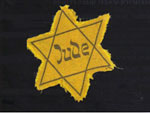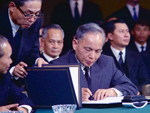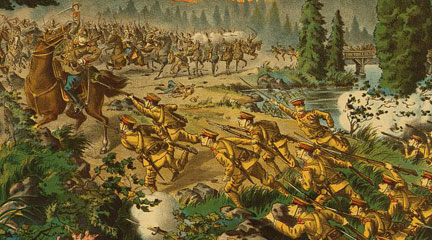After Pearl Harbor, there was just a tremendous sense of shock. The United States had never been attacked in this way, it had sought to remain neutral. The U.S. government and the Japanese government were still negotiating up to the very eve of that devastating December 7, 1941, morning.
Congress investigated and they heard from military leaders who had told them, among other things, that Japanese Americans might be dangerous. That there was a risk facing them from the possibility that all of these people—never mind that many of them had never been to Japan, they had been born in the United States, they didn’t know Japanese, didn’t know Japanese culture, that they were as thoroughly assimilated as anyone else. Nonetheless, there was a sense that—well, now that there’s war, perhaps we can’t trust these folks.
Now some of that was just the product of racial prejudice that had been there all throughout. If you go back and look at the politics of the 1910s, '20s, and '30s in the U.S. West—especially in California—there were efforts all along to say that we don’t want any more Japanese, we want to keep those who are here from acquiring land, we don’t want them to naturalize as citizens, and so on. Directed not just against people of Japanese descent, not just against people of Asian background more generally, but all throughout the 1910s and '20s there was an effort to restrict migration, to close the door. People said there were too many white ethnics coming; too many people who were European in background, they were from Southern Europe or Eastern Europe. They were Catholics, they were Jews, they weren’t old-stock “real” Americans—or wouldn’t become real Americans.
There is all of this background, and what happened is that the leaders, in Congress and the White House, decided they that would authorize the United States Army to take those measures that they deemed appropriate. Franklin Delano Roosevelt signed Executive Order 9066, and that allowed Lieutenant General John L. Dewitt—who was in charge of the western defense—to start issuing orders. Those began with curfews, freezing bank accounts, having people fired from jobs if they worked for the civil service or if they worked with defense contractors. Then ultimately, signs started to go up on telephone poles with instructions to all people of Japanese ancestry. It said that in two days—with just 48 hours notice in some instances—you had to report to an assembly center. You could only bring what you could carry, and that’s ultimately what led to the camps.
What’s interesting is there’s this rich archival history, all of these documents now that we can access. What those documents show is something truly astonishing. They show that other than General Dewitt and a few others, that the FBI, that other military leaders—including in Hawaii—they all had assessed this. They had investigated, they had looked at this—and not with our judgment now looking back—but with their judgment then at the time, with war raging, with a sense of panic. They had concluded that the Japanese Americans did not present a risk. They had actually counseled, they had written memos internally saying this is a silly thing to do, this is foolish, we will come to regret this.
The very first civilian head of the War Relocation Authority was someone named Milton Eisenhower. He was the general’s brother, he was a bureaucrat in Washington DC, he was asked to run the camps. He did it for only a few months, and he quit. He said—he said, “I predict that these camps will be regarded as a mistake.” And indeed, history has born it out.
What’s truly astonishing is if you go back and look at the record that was complied at the time—what’s so important about that is it shows not later judgment. It’s not with hindsight, it’s not with the benefit that we have of everything that’s emerged since then, of our sense of multiculturalism and diversity, it’s not about politics, and it’s not in peacetime when things are more comfortable. It’s easy for us to condemn what people decided in the past. What’s so important about these documents is that you can go back and look at them from that time period and see that already wiser heads in Washington, California, and elsewhere were saying, “This was a crazy thing to do. Why would you round up all these people?”
This is an example of how the United States, with its democratic system, can correct itself. Because even though a mistake was made, in the 1980s—what happened is Congress saw that this was a problem and in 1988 based on all of these findings they passed a different law: the Civil Liberties Act. What that law did was it said, “We were wrong, we’re sorry.” It went further, it said to the people who were interned, whose property was taken, whose liberty was lost, who were stripped of equality and dignity—it said that if you are now still alive we will pay you reparations, 20,000 dollars per person. Now most people [who] have calculated this have figured out that it is not enough to compensate for the actual loss, but that’s not what’s important. What’s important is the symbolic aspect of this. That our government as a democracy can correct itself, can look back and say, “We made mistakes then, we can do better.”
What’s interesting about Executive Order 9066 is when you read it, it seems neutral; it seems innocuous, it looks like it’s just another bureaucratic order. You would have difficulty understanding what it was all about. And indeed, that’s true of many important historical documents. Many of them look like nothing, you might pass them by, you might shrug—your eyes might glaze over because you think, “What is this boring document?!”
But what’s crucial here is that Franklin Delano Roosevelt, using the power invested in him under the Constitution within our system, gave authority to the military. What he did was he delegated. He said that the U.S. military would have the authority to do what it believed was necessary to protect the nation, and specifically to protect the nation on the west coast. So even though the language is very neutral, you would look at this and say well this doesn’t deal with race or ethnicity, I can’t even tell who this concerns. You might look at this and say I don’t even know what threat he’s talking about. So you always have to look at the context and you always have to look at what happened afterward.
Right after Pearl Harbor there was a roundup. It took place almost immediately. What happened was people of Japanese descent—along with some Italians and some Germans, almost all of whom were foreign nationals, meaning they were citizens of a different nation. For the people of Japanese descent, the Issei—that’s first generation—they couldn’t naturalize because there was a rule, there had been a Supreme Court case that said if you were not a free white person, you can’t become a citizen. It doesn’t matter how assimilated you are, doesn’t matter how long you’ve been in this country, you’ll forever be what they called “an alien ineligible to citizenship.” There’s another phrase, it’s just a lawyers’ phrase, it sounds innocuous, it doesn’t tell you anything about what’s going on, but it’s actually about race.
There was an initial roundup of many hundred people; but then, as Congress held hearings, as there was panic and concern and anger that was built on top of the racial prejudice that was already there, FDR signed 9066. And then what happened is that Lieutenant General John L. Dewitt decided that he would use the authority given to him—because even though FDR’s language is very general, very vague, very bureaucratic, what it did was transfer power. It gave the military this authority. When you go and look at what General John Dewitt ordered—the signs that were put up—they’re very stark. They say “instructions to all persons of Japanese ancestry,” so it’s clear who he has in mind. If you go back and you look at what he wrote, there’s a famous document called the “Final Report” where he explains what his plans are. Then he went and testified and he told members of Congress, “Oh, you don’t have to worry about the Italians, you don’t have to worry about the Germans, but you must worry about the Japanese until he is wiped off the face of the map.” He said, and I’m paraphrasing here, in the war, in which we are now engaged, racial affinities are not severed by migration; he said it was a “racial war,” not just a normal war, but a racial war.
You don’t see any of that reflected in Executive Order 9066. In part, that’s because when the president speaks through an official order, it almost always sounds like this, bureaucratic and legal, because that’s what it is. It’s been drafted for him by bureaucrats and lawyers. It’s meant to have a certain dignity, a certain majesty that’s accorded to official actions.
A part of the challenge for a historian is to take just the text, as neutral and innocuous as it is, and go and look in the real world and ask, what did this piece of paper—and that’s all it is, just a piece of paper, just a few hundred words—what did it actually do? What did it enable? Because words are powerful, words bring about changes in the world around us. This isn’t just a set of words, why? Because these are the words that came from Franklin Delano Roosevelt, or at least the words that he signed. So these aren’t anybody’s words, these aren’t just the words of a crank on a street corner giving a speech. These are words that have and are invested with a sense of meaning through law, through the Constitution. So as we read it—it’s important to read this and see that it’s necessary to always go back to the primary sources. But that’s not sufficient. We start there as a beginning, we don’t just end there. We ask, what did these words allow, what did they lead to?
This document is written during a time of active military hostility, and it clearly indicates—right at the very beginning—that what’s most important is “the successful prosecution of the war.” And then, let’s look at the verb there, “requires.” So this is being presented as if there’s no choice. This is one way that you justify the actions that you take, by making it seem as if it’s inevitable. It’s not actually a decision. This isn’t something where Franklin Delano Roosevelt decided he would do this, he’s required to do it. There are rhetorical tricks built into even the most innocuous, most bureaucratic, most official-looking document.
“Whereas the successful prosecution of the war requires every possible precaution.” Every. The idea here is that no possibility is going to be left out. We want to be comprehensive; we want to make the best possible effort “against espionage and against sabotage,” this tells us what the fear is. What is the risk? Espionage and sabotage. There’s a concern, not about enemies overseas, not about soldiers in uniforms who will attack us, not about the pilots who were flying the Japanese planes that bombed Pearl Harbor—the concern here is about people inside. Members of the body politic who will commit espionage and sabotage. What does this say?
“Now therefore, by virtue of the authority vested in me as the President of the United States, and Commander in Chief of the Army and Navy.” Now, what’s not said here is "vested in me under the Constitution," so this is an invocation of legal authority. What does Franklin Delano Roosevelt do with that authority? He’s saying I have this authority. Why does he have it? Because he’s President and Commander in Chief. But look at what he does in that sentence. “I hereby authorize and direct the Secretary of War, and the Military Commanders whom he may from time to time designate.” So, FDR is giving up his power. He’s saying, "Okay, I have this power, but I’m not going to actually use it, I’m going to give it to other people to use." To do what? “Whatever he or any designated Commander deems such action necessary or desirable, to prescribe military areas in such places and of such extent as he or the appropriate Military Commander may determine from which any or all persons may be excluded.” That’s the crucial language. So what he’s saying is: now the military has my authority, and what they have the authority to do is “prescribe military areas”—that just means designate, name, choose, select, he’s picked a word that’s more formal and more neutral—“from which any or all persons maybe excluded.” Now it's interesting is that they don’t exclude all persons, they actually don’t exclude any, they exclude a specific group selected by ancestry, blood, by immutable characteristics; not who they are, not what they decided for themselves, not their politics, but skin color, the texture of hair, the shape of eyes, the color of skin. That’s what ultimately was decided.
In some way, we can and we can’t blame Franklin Delano Roosevelt. He did and he didn’t make the decision. All he did was delegate this authority. Now at the time he did that he and his advisers knew what the plans were, they didn’t know the full scope and extent, but they knew the general tenor; that idea was—what the military would then do was round up specifically people of Japanese descent. That’s what was being talked about, that was the primary plan.
There were some discussions, by the way, they initially said, “Well, shouldn’t we round up people of German background, Italian background?” They concluded quickly, no. They concluded no for many reasons, not the least of which it would be impossible, there were too many, it was only a minority you could round up—a discrete, insular, smaller minority. People of German descent, then and now, make up the single largest ethnic group in the United States. More people claim German ancestry than claim the ancestry of any other single nation. Not only that, these were important voting blocks: if you tried to round up everyone of German ancestry and Italian ancestry, you can bet you wouldn’t be reelected.
So what Franklin Delano Roosevelt did was delegate this authority. If we continue reading, it’s not just this authority. The next paragraph, he says “I hereby further authorize and direct the Secretary of War and the said Military Commanders to take such other steps as he or the appropriate Military Commander may deem advisable to enforce compliance.” They don’t just get to set up internment camps, they now have the authority to compel people, to force them into those camps.
As you start to interpret documents like this, it becomes apparent how hidden away in what looks—if you just glance at this casually you have no idea what it meant—how hidden away in documents that look like just so much bureaucratic legalese, is power, is authority, is policy. It’s not just this document; I would suggest that’s generally true. When people go looking for history, sometimes they think wrongly that history is going to be big, bold, dramatic, that you’re going to see it and you’re going to know that is history! Well, sometimes—often—history consists of things that if you passed it by, if you just saw this document, you’d have no idea how momentous it is. It’s not until it’s put into action. So sometimes history is in these details.





